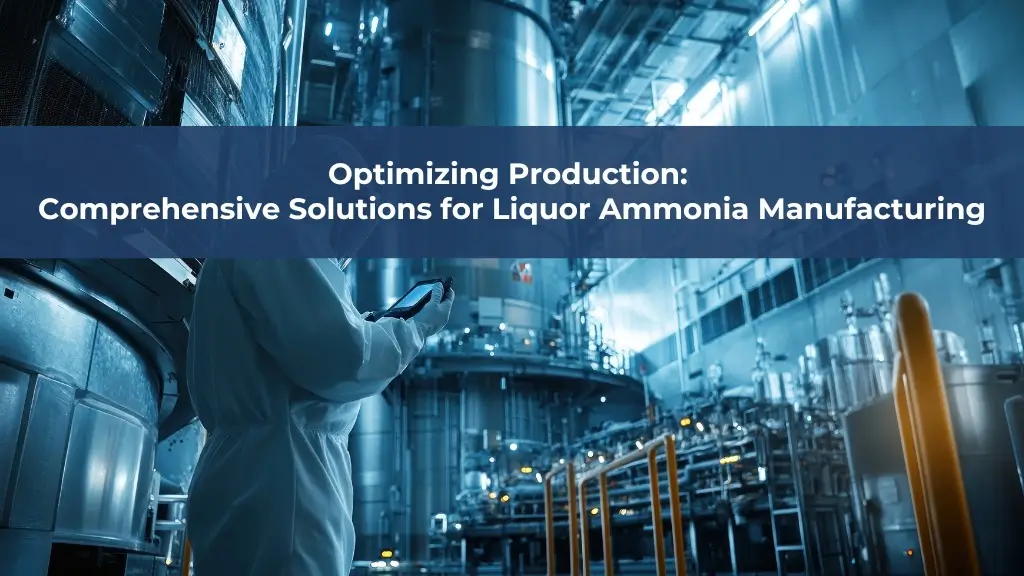Introduction
Liquor ammonia, a fundamental chemical in numerous industrial applications, plays a pivotal role in sectors ranging from agriculture to pharmaceuticals. As global demand escalates, manufacturers face the imperative of optimizing production processes to enhance efficiency and sustainability. However, the path to optimization is fraught with challenges that necessitate innovative solutions and strategic planning.
Understanding Liquor Ammonia Manufacturing
Liquor ammonia manufacturing, involving the creation of an aqueous solution of ammonia gas in water, exhibits unique chemical properties that make it invaluable in various industries. Its uses span fertilizer production, waste treatment, and refrigeration systems. Traditionally, manufacturing liquor ammonia involves the absorption of ammonia gas into water, a process that, while straightforward, is often energy-intensive and susceptible to inefficiencies.
Identifying Production Inefficiencies
The first step toward optimization is recognizing the inherent inefficiencies within existing manufacturing processes. Resource wastage, such as the excessive consumption of raw materials and water, not only escalates costs but also depletes vital resources. Additionally, high energy consumption remains a pressing issue, leading to inflated operational expenses and a larger environmental footprint.
Technological Innovations in Production
Embracing technological innovations is essential for modernizing liquor ammonia manufacturing. The application of advanced catalysis techniques can accelerate chemical reactions, thereby increasing yield and reducing energy requirements. Furthermore, the integration of automation and control systems enables precise monitoring and adjustment of process parameters, resulting in consistent product quality and minimized human error.
Implementing Lean Manufacturing Principles
Adopting lean manufacturing principles offers a systematic approach to eliminate waste and optimize workflows. By scrutinizing each step of the production process, manufacturers can identify non-value-added activities and streamline operations. Enhancing process flow reduces bottlenecks, improves throughput, and fosters a culture of continuous improvement within the organization.
Energy Optimization Strategies
Reducing energy consumption is not only economically beneficial but also environmentally responsible. Implementing heat recovery systems allows the capture and reuse of waste heat generated during production, thereby lowering overall energy usage. Additionally, integrating renewable energy sources, such as solar or wind power, can further diminish reliance on fossil fuels and reduce greenhouse gas emissions.
Environmental Considerations
Environmental stewardship is increasingly becoming a critical aspect of industrial operations. Employing emission reduction techniques, such as scrubbers and catalytic converters, minimizes the release of harmful pollutants into the atmosphere. Effective waste management and recycling practices ensure that by-products are handled responsibly, mitigating environmental impact and adhering to regulatory requirements.
Quality Control Measures
Maintaining high product quality is paramount in liquor ammonia manufacturing. Implementing real-time monitoring systems enables immediate detection of deviations from desired specifications, allowing for prompt corrective actions. Standardizing procedures across all production stages ensures consistency, reduces variability, and enhances customer satisfaction.
Workforce Training and Development
A skilled and knowledgeable workforce is indispensable for successful optimization efforts. Investing in workforce training and development programs equips employees with the expertise needed to operate advanced technologies and adhere to best practices. Emphasizing safety protocols and compliance training fosters a safe working environment and reduces the likelihood of accidents and associated downtime.
Supply Chain Optimization
Optimizing the supply chain is essential for ensuring timely availability of raw materials and efficient distribution of finished products. Effective inventory management prevents overstocking and stockouts, balancing supply with demand. Cultivating strong vendor relationships enhances collaboration, reliability, and can lead to cost savings through negotiated terms.
Cost Reduction Techniques
Implementing cost reduction techniques directly impacts the bottom line. Leveraging economies of scale allows manufacturers to reduce per-unit costs by increasing production volumes. Simplifying processes eliminates unnecessary complexity, reduces operational expenses, and can improve overall efficiency.
Case Studies of Successful Optimization
Examining case studies provides valuable insights into effective optimization strategies. Industry leaders who have successfully modernized their liquor ammonia production processes often report significant improvements in efficiency, cost savings, and environmental performance. Analyzing these best practices and lessons learned can guide other manufacturers in their optimization journeys.
Future Trends in Liquor Ammonia Manufacturing
The future of liquor ammonia manufacturing is poised to be shaped by digital transformation and sustainability initiatives. The adoption of Industry 4.0 technologies, such as the Internet of Things (IoT) and artificial intelligence (AI), promises enhanced data analytics and predictive maintenance capabilities. Sustainability efforts will continue to drive innovations in energy efficiency and environmentally friendly practices.
Conclusion
Optimizing liquor ammonia production is a multifaceted endeavor that requires a comprehensive approach encompassing technological innovation, process improvement, and environmental responsibility. By implementing the strategies outlined above, manufacturers can achieve greater efficiency, reduce costs, and position themselves for long-term success in an increasingly competitive market. It is imperative for industry players to take proactive steps toward optimization, embracing change, and fostering a culture of continuous improvement.














